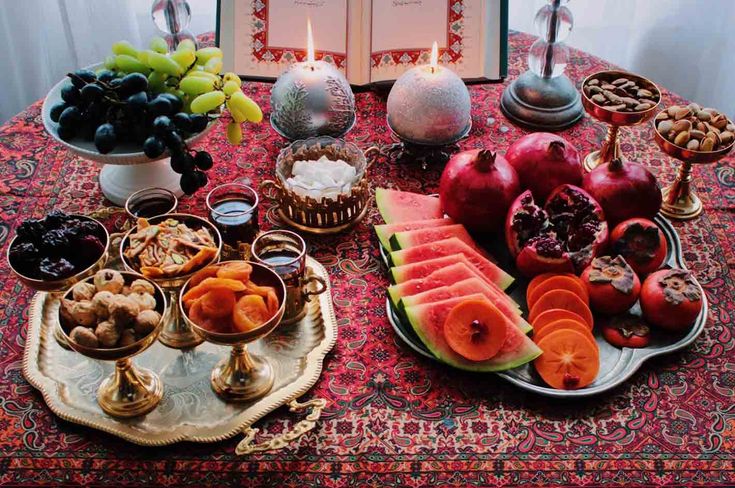Yalda Night, a cherished Iranian celebration with roots extending millennia into the past, predating the birth of Christ, holds a profound historical legacy. In an age when agriculture played a pivotal role, the sun’s radiant light symbolized prosperity. Iranians and their neighboring communities unite to commemorate Yalda as the longest night of the year, engaging in spirited festivities. These celebrations, woven into the fabric of time, not only maintain their significance but have also secured a special place in the hearts of Iranians. Join us as we explore the customs, delectable treats, and traditions associated with Yalda Night, offering a closer glimpse into this enchanting and ancient revelry.
Delving into Yalda Night’s Historical Tapestry
The origins of Yalda Night trace back to antiquity, although the exact genesis remains shrouded in mystery. Archaeologists speculate a history spanning seven thousand years, citing pottery artifacts from the prehistoric era adorned with animal motifs corresponding to Iranian months, such as goats and scorpions. While these motifs are scarce in inscriptions and archaeological findings, experts posit that traces of the Yalda Night ritual can be discerned from seven millennia ago.
Despite its ancient roots, official recognition of Yalda Night dates back approximately 500 years before Christ. Darius the Great, during his reign, incorporated Yalda into the official calendar of ancient Iranians. This calendar, amalgamating Babylonian and Egyptian calendrical systems, exemplifies the cultural exchange prevalent during that era.
Celebrating Yalda: A Night of Joyous Traditions
In Iran, Yalda Night unfolds through jubilant gatherings and time-honored traditions. Families and friends unite to observe the longest night of the year, sharing in a special meal featuring culinary delights like herbed rice and fish. Central to the celebration is the vibrant Yalda spread. The evening is enriched with storytelling, poetry recitation, and readings from the epic Shahnameh, fostering cultural depth and a sense of togetherness. Illuminating candles and reveling late into the night signify the triumph of light over darkness. Yalda Night becomes a tapestry of joy, reflection, and the exchange of warmth among loved ones.
Yalda Night Meaning
The term “Yalda,” derived from the Syriac word denoting “birth” or “nativity,” has linguistic roots in the Syriac language, prevalent among early Christians. This etymology is unveiled through scrutiny of dictionaries and historical texts. Abū Rayḥān al-Bīrūnī, a polymath and calendar scholar, interprets Yalda Night as the “birth of the greater sun,” encapsulating the idea of the sun’s birth. His insights, chronicled in the book “Āthār al-Bāqiyah,” delve into the calendars and festivities of diverse societies.
While the exact assimilation of the term “Yalda” into the Persian language remains elusive, historical records suggest that early Christians, facing adversity in Rome, migrated to Iran. Due to cultural affinity, the Syriac word found resonance in Persian, evolving into the term we use today to reference this ancient and captivating celebration.
Shab-e Yalda: Unveiling the Winter Solstice Traditions
The night of “Cheleh” intertwines seamlessly with the spirit of Yalda Night, as it signifies the commencement of the major winter period known as “Cheleh.” Commencing right after Yalda Night, this period encompasses both major and minor Cheleh, reflecting ancient Iranians’ intricate understanding of seasons and their influence on agricultural and husbandry activities.
In antiquity, Iranians adhered to a comprehensive calendar, featuring two distinct Cheleh seasons. The summer Cheleh commenced with the month of Tir, while the winter Cheleh unfolded from the month of Dey. Each Cheleh was subdivided into major and minor phases, with the initial forty days denoting the major Cheleh, succeeded by the subsequent twenty days as the minor Cheleh.
Shab-e Yalda Meaning
The major winter Cheleh, emerging immediately post-Yalda Night, marks the onset of winter’s biting cold, persisting until the tenth day of Bahman. Subsequently, the minor Cheleh takes its course, extending until the first day of Esfand. The cold during the minor Cheleh is milder, causing fewer disruptions. The climactic “Char-Chaar” phase, spanning the last four days of the major Cheleh and the first four days of the minor Cheleh, epitomizes the peak intensity of cold during this period.
Yalda Night, deeply ingrained in ancient traditions, carries profound significance for Iranians. The term “Yalda,” originating from Syriac, translates to “birth” or “nativity.” Rooted in the annals of history for thousands of years, the celebration marks the longest night, symbolizing the triumph of light over darkness. On this special night, Iranians and neighboring communities come together in festive gatherings, embracing storytelling, savoring seasonal fruits, and partaking in age-old customs. Yalda Night acts as a cultural bridge, connecting past and present, where families and friends revel in the warmth of togetherness and the hope for brighter days ahead.
The Timeless Traditions of Yalda Night Have Endured Through the Ages
Fire Gathering: In ancient times, people congregated around a fire, symbolizing the sun’s warmth. Modern-day heaters have replaced this ritual, preserving the essence of warmth and dispelling darkness.
Storytelling: The tradition of “Masal-Gooyi,” akin to poetry reading and storytelling, once captivated gatherings. Elders shared tales of mythical creatures, enthralling and entertaining the younger members.
Hafez Fortune-Telling: Hafez’s poetry, adorning the festive table, holds a mystical allure on Yalda Night. Guests express wishes, open his poetry for insights into the future, and bask in the uplifting and hopeful verses.
Shahnameh Reading: Yalda Night is incomplete without the melodic reading of the Shahnameh, the epic Persian Book of Kings. This tradition, steeped in Iranian culture, adds an enchanting narrative to the celebratory atmosphere.
As for the customs on Yalda Night in Iran, they uniquely reflect the nation’s rich cultural tapestry. Special dishes like herbed rice and fish grace tables, accompanied by Yalda Ajil—a delightful mix of pistachios, almonds, walnuts, and hazelnuts. Watermelon and pomegranate seeds enhance the vibrancy of the colorful Yalda Night spread. These culinary traditions, shared among family and friends, create a warm and joyous atmosphere, marking the celebration of the longest night of the year in Iran.
Yalda Night: A Feast of Symbolic Fruits and Delectable Delights
Fruits take center stage on the vibrant Yalda Night table, with a special emphasis on the rich hues of red symbolizing the sun. Pomegranate stands out as the quintessential fruit for Yalda Night, its ancient reverence rooted in symbolism associated with fertility and abundance, embodied by its plentiful seeds. The radiant red color not only represents happiness but also serves as a sunlit tribute. Consuming pomegranate on Yalda Night is believed to be intertwined with the magical influence of its vibrant essence. Another star on the Yalda table is watermelon, sharing the same vibrant red hue, acting as both a sun symbol and a nostalgic nod to the warmth of summer and its comforting heat.
The Enchanting Yalda Night Spread
Yalda Night’s allure extends to the enchanting ritual of the festive table and its mouthwatering offerings. The Yalda Night spread features specific fruits, special nuts (referred to as “Ajil”), and an array of delectable foods. In ancient times, a Yalda table known as “Mizd” was meticulously arranged on the night of Chelleh. This table showcased a variety of fresh and dried fruits, alongside the traditional Ajil or “Lork,” a centerpiece considered the feast of the celebration. Complementing these delights were essential components such as the fire container (Aatishdan), a vessel for scents (Atardan), a container for seeds (Bokhordan), and the “Barsem,” a tool crafted for reciting prayers, often made from a specific plant branch or fashioned from metals like brass and silver.
A Culinary Tapestry of Tradition
In conclusion, Yalda Night, marking the pinnacle of autumn and the onset of winter, holds profound significance as the longest night heralding the gradual lengthening of days. Celebrated fervently in Iran and Persian-speaking countries, the customs and traditions of Yalda have transcended borders and cultures. Since the time of the Achaemenids, Iranians have embraced Yalda Night, and its cultural richness has resonated far beyond Iran, reaching countries such as Afghanistan, Pakistan, China, South Korea, Peru, Scotland, Russia, Africa, and more.
Last Word
As a festive bridge between seasons, Yalda Night unites people to savor the warmth of companionship, indulge in special foods, and partake in age-old rituals that symbolize the triumph of light over darkness. It stands as a testament to the enduring cultural heritage that binds communities together, fostering a sense of unity and joy during this celestial celebration.



falbobrospizzamadison Bisexual porn jkkıjxxx.CLJNLQFHpgs
landuse Cunnilingus porn lancdcuse.3egjuttF8Yd
jenniferroy ヴィンテージポルノ japanesexxporns.eZvbcdKiuwD